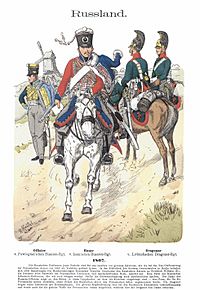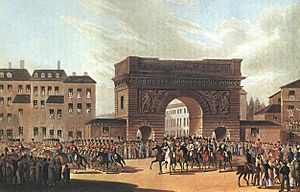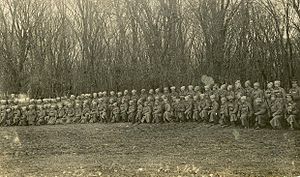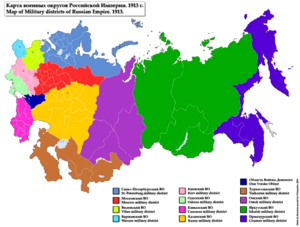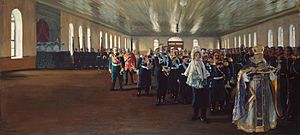Imperial Russian Army facts for kids
Quick facts for kids Imperial Russian ArmyРусская императорская армия |
|
|---|---|

Cockade of the Imperial Russian Army
|
|
| Active | 1721–1917 |
| Country | |
| Allegiance | |
| Type | Army |
| Size | 12,000,000–15,000,000 during World War I 4,200,000 during the Russian Civil War |
| Engagements | Great Northern War Russo-Turkish Wars Russo-Swedish Wars Russo-Persian Wars Russo-Polish Wars Seven Years' War Napoleonic Wars Caucasian War Crimean War Russo-Japanese War World War I Russian Revolution |
| Commanders | |
| Commander-in-chief | Russian Emperor |
| Notable commanders |
Peter the Great Alexander I Boris Sheremetev Alexander Menshikov Mikhail Golitsyn Peter Lacy Khristofor Minikh Pyotr Saltykov Pyotr Rumyantsev Alexander Suvorov Grigory Potemkin Andrei Rosenberg Mikhail Kutuzov (Golenishchev-Kutuzov) Mikhail Barclay de Tolly Pyotr Bagration Mikhail Vorontsov Nikolay Kamensky Leonty Bennigsen Mikhail Miloradovich Ivan Paskevich Aleksey Yermolov Ivan Dibich Mikhail Gorchakov Mikhail Skobelev Aleksei Brusilov Nikolai Ivanov Alexey Kaledin |
The Imperial Russian Army was the main land army of the Russian Empire. It was active from about 1721 until the Russian Revolution in 1917. In the early 1850s, the army had over 900,000 regular soldiers. It also had nearly 250,000 irregular soldiers, mostly Cossacks.
Contents
- How the Army Started
- Joining the Army: Conscription
- A Great General: Alexander Suvorov
- Facing Napoleon: The Army in 1805
- The Napoleonic Wars
- Army Changes and Reforms
- World War I and the Revolution
- How the Army Was Organized
- Jewish Soldiers in the Russian Army
- Cossacks: Special Horsemen
- Different Peoples in the Army
- Ranks and Insignia in 1917
- Images for kids
How the Army Started
Before Peter the Great, Russian rulers had special musketeer groups called streltsy. These groups were first created by Ivan the Terrible. While they were once strong, they later became unreliable. When there was a war, farmers were also called to fight.
New military units, called "regiments of the new order," were formed in the 1600s. These units were set up like armies in Western Europe. There were different types of regiments, like regular soldiers, dragoons (soldiers who rode horses but fought on foot), and reiters (horsemen).
In 1631, Russia created two regular regiments. More regiments were formed during the Smolensk War (1632–1634). At first, these soldiers were volunteers, Cossacks, and children of landless nobles. Most of their leaders were from other countries. After the war with Poland, these regiments were stopped. But they were created again during another Russo-Polish War (1654–1667) and became a key part of the Russian Army.
By 1681, there were 33 regular regiments (61,000 men) and 25 dragoon and reiter regiments (29,000 men). These new types of regiments made up more than half of the Russian Army by the late 1600s. They were used to create the regular army in the early 1700s.
Joining the Army: Conscription
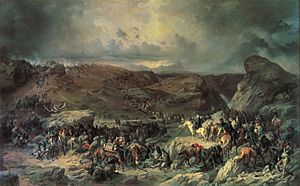
Conscription, which means people are required to join the army, was started by Peter the Great in 1699. Peter built a modern army based on the German model. He allowed talented common people to become officers, and they could even gain noble titles. This was later changed by Catherine the Great.
Farmers and townspeople were chosen for the army based on how many people lived in their area. At first, it was based on the number of households. Later, it was based on the total population.
In the 1700s, soldiers had to serve for their whole lives. This was later reduced to 25 years in 1793. By 1855, it was only 12 years of service plus three years in the reserve.
A Great General: Alexander Suvorov
The history of the Russian Army in the late 1700s is closely linked to General Alexander Suvorov. He is known as one of the greatest generals in history because he never lost a battle.
From 1777 to 1783, Suvorov served in the Crimea and the Caucasus. He became a general in 1783. From 1787 to 1791, he fought against the Turks in the Russo-Turkish War (1787–1792) and won many battles. Suvorov also helped Russia win against the Poles during the Kościuszko Uprising.
Facing Napoleon: The Army in 1805

Russia was a major European power, so it became involved in the wars with Revolutionary France and Napoleon's empire. The new emperor, Alexander I of Russia, became a very important leader during this time.
In 1805, the Russian Army was still organized in an older way. There were no permanent large units above the regiment level. Senior officers were usually from noble families. Soldiers were often beaten to make them follow orders. Many lower-level officers were not well trained. However, the Russian artillery (cannons) was very good. The soldiers who operated the cannons were well trained and fought hard to protect their weapons.
Both the Russian and Austrian armies were defeated by Napoleon at the Battle of Austerlitz in 1805.
The Napoleonic Wars
The War of the Fourth Coalition (1806–1807) began shortly after the previous war ended. It involved Prussia, Russia, and other countries against France. Prussia decided to go to war alone, without waiting for Russia. This was a mistake, as Napoleon quickly defeated the Prussian armies.
Napoleon then moved east towards Warsaw. In late 1806, there were some early fights between the French and Russians, but no clear winner. Napoleon's troops settled down for winter. However, the new Russian commander, Levin August von Bennigsen, attacked the French. The two sides fought a very bloody battle at Eylau in February 1807, but neither side won clearly.
In June, Bennigsen attacked again, but Napoleon quickly stopped him. Napoleon then chased the Russians and badly defeated them at the Battle of Friedland on June 14. After this loss, Emperor Alexander I had to make peace with Napoleon at Tilsit in July 1807. Russia did not lose much land and became an ally of Napoleon. Napoleon created the Duchy of Warsaw from land that used to belong to Prussia.
At a meeting in 1808, Napoleon and Alexander agreed that Russia should force Sweden to join the "Continental System." This system was Napoleon's plan to stop trade with Britain. This led to the Finnish War (1808–1809), where Russia gained Finland from Sweden.
Russia also fought the Russo-Turkish War from 1805 to 1812. Russia gained Bessarabia from Turkey in 1812.
War with Britain and France
Joining Napoleon's trade blockade against Britain hurt Russia's economy. In 1810, Alexander I decided to stop following this rule. This led to a major change in the army, led by Michael Andreas Barclay de Tolly, the Minister of War.
The alliance between Russia and France became difficult. Napoleon worried about Russia's plans for important waterways. Alexander was suspicious of the Duchy of Warsaw, a Polish state controlled by France. This led to the War of the Sixth Coalition from 1812 to 1814.
Napoleon Invades Russia
In 1812, Napoleon invaded Russia. He wanted Alexander I to rejoin the trade blockade against Britain. Napoleon's huge army, called the Grande Armée, had 650,000 men. They crossed into Russia on June 23, 1812.
Russia declared it a "Patriotic War." The Russian army used a "scorched earth" tactic, meaning they destroyed everything useful as they retreated. This made it hard for Napoleon's army to find food and supplies. The only major battle was the Battle of Borodino on September 7. It was a very bloody fight, and the Russians eventually retreated. This opened the way to Moscow.
On September 14, the French captured Moscow. However, the Russian governor ordered the city to be burned. Alexander I refused to give up. With no clear victory, Napoleon had to leave Moscow. This began the terrible "Great Retreat." Many French soldiers died from hunger and freezing weather. Napoleon's army was almost completely destroyed. By December, only a small part of his army remained. Napoleon left his army to return to Paris.
Campaigns in Germany and France
As the French retreated, the Russians chased them into Poland and Prussia. Prussia then joined Russia against France. The Russian army, led by Peter Wittgenstein, continued to fight. Aleksey Petrovich Yermolov became a key commander, fighting in many important battles, like the Battle of Leipzig.
In 1813, Russia also gained land in the Caucasus region from Iran. By the early 1800s, Russia also had a presence in Alaska, far across the world.
In 1814, Russian-led forces marched towards Paris. Alexander I used a clever move to capture Paris before Napoleon could send more troops. This ended the war. In 1814, Russia, Britain, Austria, and Prussia formed the Quadruple Alliance. This group worked together to keep peace in Europe and prevent France from expanding again. Russia's army had proven it could defeat Napoleon and reach Paris, which gave Russia a lot of influence in Europe.
After Napoleon's defeat, Alexander I played a big part in redrawing the map of Europe at the Congress of Vienna in 1815. Many Russian commanders were celebrated in European cities. Alexander also started the Holy Alliance, an agreement for European rulers to act based on Christian values.
Army Changes and Reforms
After Russia lost the Crimean War (1853–56), Emperor Alexander II ordered military reforms. The Minister of War, Count Dmitry Milyutin, made many changes from 1861 to 1881. He ended the old system of forcing children to join the army. Instead, a new system of conscription was introduced for all men. Military districts were also created across the country.
On January 1, 1874, a new law made military service required for all 20-year-old men. They served for six years in the active army and nine years in the reserve. This created a large group of experienced soldiers who could be called up if there was a war. It also meant Russia could have a smaller army during peacetime.
The system of military education was also improved. All new soldiers were given basic education. Milyutin's reforms were a big step in Russian history. They changed the army from a professional force to a modern army with conscription, similar to armies today. Before these reforms, the Russian Army did not have permanent barracks. Soldiers lived in temporary shelters.
The army fought against the Turks in the Russo-Turkish War (1877–78).
During the Boxer Rebellion in China (1900), 100,000 Russian troops fought to control parts of Manchuria and protect railroads.
The army was defeated by Japan in the Russo-Japanese War of 1904–05. Important battles included the Siege of Port Arthur and the Battle of Mukden.
World War I and the Revolution
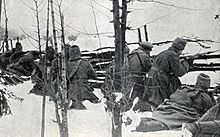
When World War I began, Emperor Nicholas II made his cousin, Grand Duke Nicholas, the Commander-in-Chief. When the army was ready for war, it had 115 infantry divisions and 38 cavalry divisions. It also had nearly 7,900 cannons.
The war on the Eastern Front began with Russian attacks into East Prussia and Galicia. The attack in East Prussia ended in a Russian defeat by Germany at the Battle of Tannenberg (1914). Russia also sent troops to France in 1915. During the Russian Revolution of 1917, the Imperial Russian Army fell apart. The remaining parts of the army later became part of the new Red Army.
How the Army Was Organized
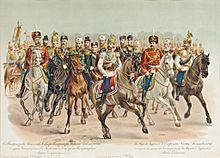
During the Napoleonic Wars, the Imperial Russian Army was organized similarly to how it had been in the 1700s. Units were assigned to different campaign headquarters. The "army" was often named after its main commander or the area where it was fighting.
The army had regular European parts, like the monarch's guard, infantry, cavalry, and artillery. But it also had a very large group of semi-regular Cossacks. In peacetime, Cossacks guarded Russia's southern borders. In wartime, they were excellent light cavalry. They were very good at scouting and gathering information. The Ukrainian parts of the Empire also provided most of the Hussar and Ulan regiments for the regular light cavalry.
Another special part of the army was the Narodnoe Opolcheniye, which were irregular troops. These were citizen militias that helped the regular army.
In 1806, many older military inspections were replaced by divisions, similar to the French model. By 1809, there were 25 infantry divisions. Each division had three infantry brigades and one artillery brigade. When Barclay de Tolly became Minister of War in 1810, he made more changes. He created separate grenadier divisions and dedicated one brigade in each division to light infantry for skirmishing.
Imperial Guard
During the Napoleonic Wars, the Imperial Russian Guard was led by Grand Duke Konstantin. The Guard grew from a few regiments to two infantry divisions and two cavalry divisions by the end of the 1814 campaign.
Guard Infantry
In 1805, the Guard Infantry included regiments like the Preobrazhensky Lifeguard regiment and the Semenovsky Lifeguard regiment. By 1812, at the Battle of Borodino, the Guard Infantry Division had more regiments, including the Izmailovsky Lifeguard regiment and the Finnish Lifeguard regiment.
Guard Cavalry
In 1805, the Guard Cavalry included the Lifeguard Hussar regiment and the Chevalier Guard Regiment. By 1812, at Borodino, the Guard Cavalry had more units, such as the Horse Guard Regiment and the Lifeguard Dragoon Regiment.
Guard Artillery
The Guard also had its own artillery units, like the Lifeguard Artillery Battalion in 1805. By 1812, it included the Lifeguard Artillery Brigade and the Lifeguard Horse Artillery.
The Guard also had Cossack units, like the Lifeguard Cossack regiment.
The General Staff Academy was started in 1832 in Saint Petersburg. It trained officers for the army's General Staff.
The army fought against the British and French during the Crimean War (1853–56).
Jewish Soldiers in the Russian Army
On August 26, 1827, Nicholas I of Russia made a law called the "Statute on Conscription Duty." This law said that all Russian males aged 12 to 25 had to serve in the army for 25 years. This was the first time that the large Jewish population was required to serve. Nicholas I believed that in the army, Jewish people would learn Russian and useful skills, and become loyal citizens.
Many Jewish families tried to leave the Russian Empire to avoid this army service. Because of this, the government used people called khappers. These khappers would forcibly recruit Jewish children for the army. Sometimes, they even took children as young as 8 years old. By the time the empire ended, about 1.5 million Jewish soldiers had served in the Russian military. At first, many Jewish people were unsure about serving, but by 1880, they were fully part of the Russian military.
Cossacks: Special Horsemen
In the Russian Empire, the Cossacks were organized into several groups called voiskos or "hosts." These were named after the regions where they lived, often along Russia's borders. Each host had its own leaders and traditions, as well as unique uniforms. However, by the late 1800s, their uniforms and ranks became more like the regular Imperial Russian Army.
Each Cossack host had to provide regiments for the Imperial Russian Army and for border patrol. Most Cossacks served as cavalry (soldiers on horseback). But some larger hosts also had infantry (soldiers on foot) and artillery units. Three Cossack regiments were part of the Imperial Guard, and the konvoi was the emperor's special mounted escort. These Imperial Guard regiments wore very colorful and fancy uniforms.
Different Peoples in the Army

The Cossack groups also included Muslim Mishar Tatars. Bashkirs were also given Cossack rank. Muslim Turkic people and Buddhist Kalmyks also served as Cossacks. For example, the Ural, Terek, Astrakhan, and Don Cossack hosts had Kalmyks. Muslim Mishars, Teptiars, and Bashkirs joined the Orenburg Cossack Host.
Bashkirs and Kalmyks in the Russian military fought against Napoleon's forces. They were good at overwhelming enemies but not in very intense battles. They often used traditional weapons like arrows, bows, and close-combat weapons. Bashkir women also fought in some regiments. Napoleon's forces faced Kalmyks on horseback. These mounted Kalmyk and Bashkir forces were available to Russian commanders during the war against Napoleon. Kalmyks and Bashkirs served in the Russian Army even in France.
Ranks and Insignia in 1917
- For more details on ranks and insignia
| Infantry | Artillery | Cavalry | Cossack host | Shoulder strap, epaulette |
|---|---|---|---|---|
| Ryadovye (Enlisted personnel) | ||||
| Ryadovoy (en: Private) | Cannoneer | Ryadovoy, Hussar, Dragoon, Uhlan, Cuirassier |
Cossack |  |
| Yefeytor (Gefreiter) | Prikasny |  |
||
| Unter-ofitsery (Under Officers/NCOs) | ||||
| Mladshy unter-ofitser (Junior Corporal) |
Mladshy feyerverker (Junior Feuerwerker) |
Mladshy unter-ofitser | Mladshy uryadnik (Junior Cossack Corporal) |
 |
| Starshy unter-ofitser (Senior Corporal) |
Starshy feyerverker (Senor Feuerwerker) |
Starshy unter-ofitser | Starshy uryadnik (Senior Cossack Corporal) |
 |
| Feldfebel (Sergeant) | Vakhmistr (Wachtmeister) |  |
||
| Podpraporshchik (Junior Praporshchik) |
Podkhorunzhy (Junior Cossack Praporshchik) |
 |
||
| Zauryad-praporshchik (Deputy Praporshchik) | — |  |
||
| Ober-ofitsery (Upper officers, senior officer corps) | ||||
| Praporshchik (wartime only) |
— |  |
||
| Podporuchik (Junior Lieutenant) | Kornet (Cornet) | Khorunzhy (Chorąży) |  |
|
| Poruchik (Lieutenant) | Sotnik (Cossack Lieutenant) |  |
||
| Shtabs-kapitan (Staff Captain) | Shtabs-rotmistr (Stabsrittmeister) | Podyesaul (Junior Yesaul) |  |
|
| Kapitan (Captain) (after 1884 it was upgraded to level VIII, and became a staff officer rank) |
Rotmistr (Rittmeister) (after 1884 it was upgraded to level VIII, and became a staff officer rank) |
Ysaul (after 1884, it was upgraded to the VIII, and became a staff officer rank) |
 |
|
| Shtab-Ofitsery (Staff officer ranks) | ||||
| Mayor (Major) (abolished in 1884) |
Voyskovay starshina (until 1884) |
 |
||
| Podpolkovnik (Lieutenant colonel) | Podpolkovnik (until 1884) |
 |
||
| Voyskovay starshina (from 1885) (Lieutenant colonel) |
||||
| Polkovnik (Colonel) |  |
|||
| General officers | ||||
| General-major (Major general) |  |
|||
| General-leytenant (Lieutenant general) |  |
|||
| General ot infanterii (General of the infantry) |
General ot artillerii (General of the artillery) |
General ot kavalrii (General of the cavalry) |
 |
|
| General-feldmarshal (General field marshal) |  |
|||
Images for kids


